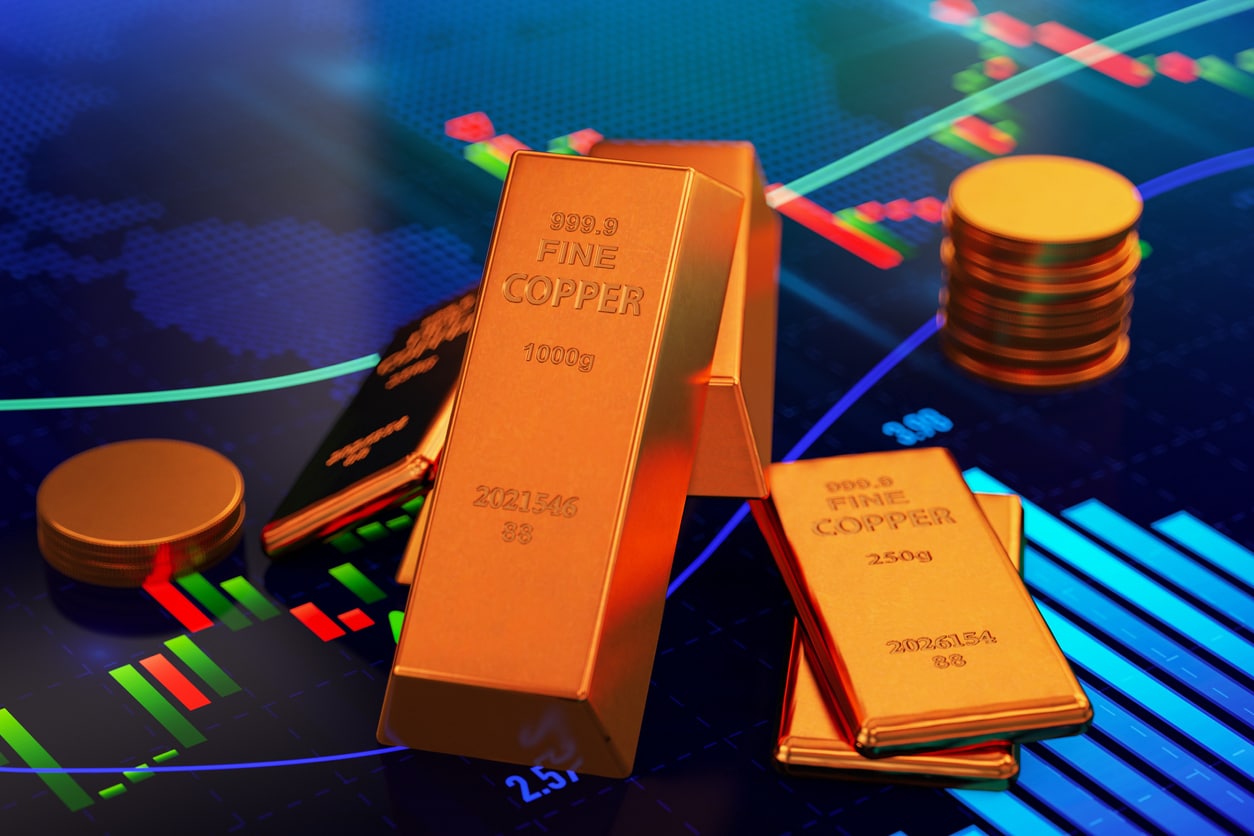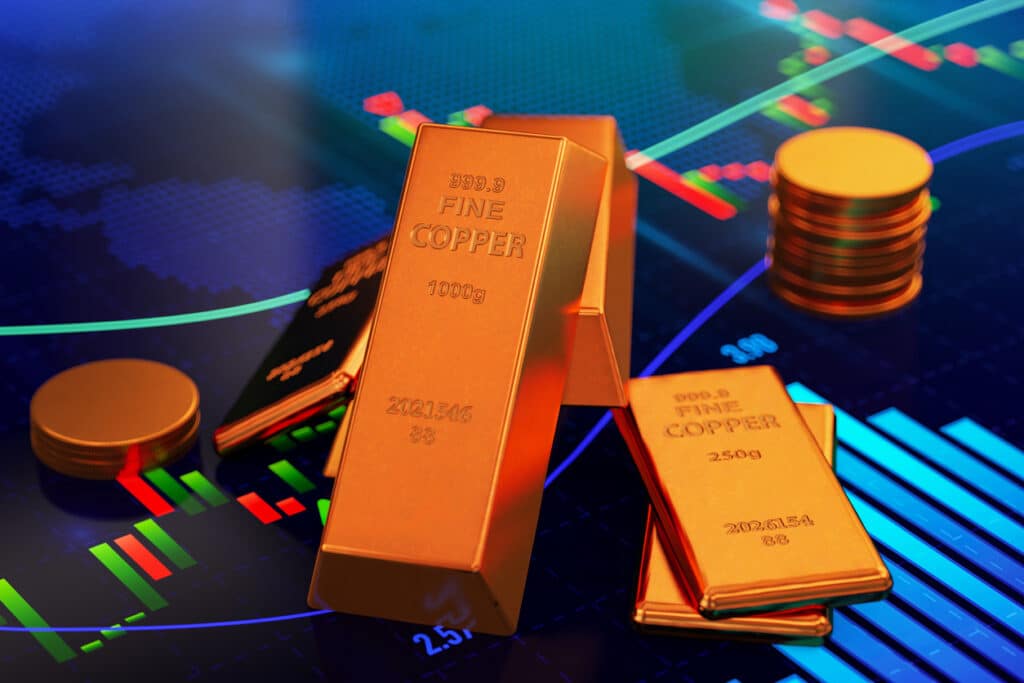
Base metals must not be confused with precious metals (PMs) – gold, silver, platinum, and palladium. A critical difference is that buyers of PMs must go the extra mile to store them securely because of their high value, which leads to complications. The latter includes storage, insurance, and transportation, significantly increasing quoted spot prices. Nonetheless, there are other ways to invest or trade in PMs that overlap with base metals (BMs), which we deal with below. First, however, as an introduction, let’s identify what falls into the BM category and how the metals attract investor interest.
In this article, we will delve into the uniqueness of base metals, what sets them apart from PMs and other commodities, and, most crucially, how their differences impact BM trading in the markets.
Base Metals: What are they and what is their use?
BMs are copper, aluminium, lead, nickel, tin, and zinc (among others). The primary function of BMs is for use in commercial activities.
- Copper – most of the copper usage in the US comes from scrap, not freshly mined metal. It is estimated that the market ballooned to USD 620.2 million in 2021 and is expected to double in size by 2030 at a 4.2% compound annual growth rate (CAGR). The primary driver is vehicle electrification, which uses three to four times more copper than combustion-engine vehicles.
- Aluminium is a staple BM for the transportation industry (i.e., aircraft, cars, and bicycles) and is relied upon for its anti-corrosion properties. It is also used in the food and beverage industries to make drinks cans, kitchen foil, and packaging. As a result, it’s a “monster market” expected to expand at a CAGR of 4.68%, achieving around $190,660.54 million by 2027.
- Lead is used in manufacturing batteries with various other applications in energy, data centres, transport, construction, semiconductors, and health. Recycled lead meets 50% of the world’s needs due to lead mining rapidly declining as regulation obstructs pulling it out of the ground more and more. By revenue metrics, the US recycled lead marketplace in 2022 was $17.1 billion.
- Zinc – a staple alloy additive- significantly improves other metals (e.g., it combines with copper to create brass). It is used in manufacturing cars, electrical components, and household fixtures. The trade is expected to touch $74.4 billion in 2027, growing at a CAGR of 4.4% and expanding into galvanised steel, smartphones, electric vehicles, mild hybrid engines, power grid storage, and infrastructure development in India, Brazil, and Indonesia.
- Tin – by 2030, the tin market is expected to grow by 3.70% CAGR to reach $9.35 billion globally. It’s a soft, pliable, silvery-white metal, malleable and ductile, extracted from the “tin-rich” mineral cassiterite. It is used in metal, alloy, and compound applications (i.e., solder, tin plating, and chemicals).
Finally, many other lesser-known base minerals have one thing in common with those described above: they are all used in manufacturing to construct products that the general public and businesses use daily.
Background
As long as elements demonstrate value in commerce, entrepreneurs and traders will search for opportunities to trade in them. However, unlike PMs, where there’s a mystical allure around holding them in one’s safe, bank deposit, or vaults, that’s not the case here. However, suppose factories and their storage facilities require tons of the stuff for processing in the supply chain. In that case, storage, insurance, and transportation enter the picture – especially when the buyers of the BMs expect a value increase.
Please note: The context of this article focuses on traders and straightforward investing. Therefore, all the complexities of physically securing the BMs fall outside our coverage (except as addressed in ETFs below). That said, there’s substantial ground to cover and understand.
Exchange Traded Funds (ETFs) in base metals
There’s no doubt that the PMs attract most of the ETF attention, probably because of the publicity around them as inflationary hedges and counter-cyclical assets stream through the media and reports daily. However, BM alternatives provide another authentic diversification alternative. Why? Because BM ETFs provide opportunities by:
- Region/International
- Investment strategy
- Metal type
- Overlaps and combinations of (1) to (3) above
The attraction here is the considerable flexibility and simplicity of securing the precise exposure for one’s portfolio without complicated equity loading or fathoming out index basket pricing. Furthermore, it’s not just a matter of buying into a fund that physically owns a BM or BMs. Instead, consider that there are ETFs that converge on entities that:
- Mine BMs
- Extract them
- Distribute them
- Embark on explorations to find them
- Trade in them
- Fund all the above
Remember, BM prices can be highly volatile, frequently reacting dramatically to events in third-world countries that produce specific metals. Therefore, ETF managers have introduced sophisticated strategies over time, aligning with shorting the BMs (inverse ETFs) or borrowing heavily against the asset holdings (labelled as leveraged ETFs). In both instances, the implications take advantage of “inside track” knowledge in the various segments. So, connecting into these convoluted trading vehicles, in a way, abdicates options trading in BMs (which we deal with below) to the professionals. However, for now:
- Investors should be aware that selling BMs at current prices for delivery in the future on the premise future prices will drop is a high-risk gameplay.
- So too, is deploying multiples of equity capital to magnify returns. Later in this article, you’ll see that the results aren’t pretty when such initiatives backfire.
Notably, Regional/International BM ETFs provide opportunities to back operations in other countries (perhaps growing significantly faster than local jurisdictions) while simultaneously achieving currency diversification. Then, BM ETNs – funds investing in Exchange-traded notes – deliver shares or units of ownership to investors in debt securities attached to BM investing (similar to bonds). In many cases, these provide the loans behind leveraged ETFs.
The crucial principle to remember here is that traders and investors in BM ETFs are not direct owners of the fund’s assets (i.e., securities or physical BMs owned by the fund). The consequences are that the ETF manager (under strict SEC regulations) is responsible for acquiring, selling, insuring, storing, leveraging, shorting, or otherwise transacting in options on BM trading platforms following fund protocols.
The investor sees none of these actions at work, only the net results in issued reports. Look at the management fees in the available ETFs and the verticals they operate in before committing to them. Of course, there’s considerable comfort in knowing professionals are at the helm in almost every instance, arranging the most economical routes to acquiring, holding, and reselling BMs. As a result, the management fees can be worth paying.
Options trading base metals
We’ve seen above in ETFs that options are an acceptable method for trading BMs on reputable platforms across a broad BM base. So, for instance, it’s possible to buy (i.e., go long) or sell (i.e., go short) for a massive BM quantity earmarked for delivery in the future at a changed price.
For Example:
- Suppose you go long for 100,000 pounds of copper at $4.12 per pound on 1st April to pay the seller (on the other side of the contract) on the 30th of the same month.
- Assume on the delivery date (or before), the price bumps up to $4.54.
- You can sell your contract earning 100,000 x $0.42 or $42,000, less platform commissions (relatively negligible), without handling the copper in any shape or form.
- The broker in the middle deposits $42,000 into your bank account.
It seems easy, but here are the complications:
- You cannot take any BM contracts to term and risk having to accept delivery of or deliver massive copper poundage. In other words, traders in BM contracts must neutralise their positions by reversing the deal before the closing date (i.e., long traders sell, and short sellers buy their contracts out.)
- In our example above, committing to 100,000 copper pounds requires $412,000 capital and reserves for expenses (say $3000 for $415,000 total). Very few traders can afford that, so they leverage up, as described in EFTs above. How easy is that to do? Many brokers stand ready to lend investors multiples of their stake to buy and sell BMs in futures contracts, going as high as 100/1.
For Example:
- An investment/trader syndicate with $20,750 at its disposal can usually secure 20 times leverage (i.e., $20,750 x 20 = $415,000), sufficient to buy the 100,000 pounds of copper per our example above (i.e., $415,000 with expenses).
- The other side of the coin is that leverage magnifies losses as much as it accelerates winnings. Why? Because if the copper price moves in the wrong direction, brokers get nervous, resulting in possible margin calls (calling traders to add equity to the trade) and creating stress as stakeholders watch their original funds dwindle (perhaps even disappear).
Think of it this way: even without a margin call, a $42,000 win or loss on $20,000 equity in one month is mind-boggling – more than doubling equity or wiping it out (and creating liability to boot), although as a ratio of the total outlay of $415,000, it’s around a relatively low 10%. So, with this in mind, approach leveraging circumspectly, noting that not all BMs trade the same way. Therefore, it’s wise to:
- Only transact those with proven liquidity, meaning you can instantly get in and out of contracts.
- Conversely, avoid thinly traded exotic metals that disallow the fast transactions you need to move in and out safely. In other words, knowing you can exit when the time is right without hassle.
- Insert stop losses to limit losses and, most critically, avoid margin calls if leveraged.
Related Articles
Conclusion
Anyone asking, “What are base metals?” and “How do I invest in them?” should now know enough to venture into the trading arena (versus commercial-centric verticals). You’ve learned that this has nothing to do with personally owning BMs in physical formats – only as diversification assets with fast-in-and-out positions to take advantage of price volatility. If going the investor route in ETFs, let the professionals take care of transporting, storing, insuring, and reselling physical BMs for you as an SEC-covered shareholder.
Also, you must appreciate that the options market – where taking possession of the metal isn’t on the cards – is ideal for numerous BM trades monthly with the possibility of:
- Substantial returns if you can shoulder the leveraging risks.
- Massive capital collapse if you let borrowing get out of control (with no stop losses and illiquid metal selections).
In other words, entering options contracts on broker platforms is for seasoned BM traders, while ETFs are more for wealth-oriented investors desiring portfolio diversification without transactional hassle. This should help clarify BM investing/trading from all angles and help you make an informed decision on the available options.
Forextraders' Broker of the Month
BlackBull Markets is a reliable and well-respected trading platform that provides its customers with high-quality access to a wide range of asset groups. The broker is headquartered in New Zealand which explains why it has flown under the radar for a few years but it is a great broker that is now building a global following. The BlackBull Markets site is intuitive and easy to use, making it an ideal choice for beginners.


